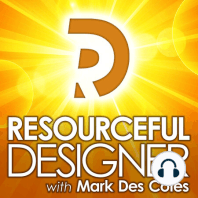14 min listen

Discovery Process - Doing It Right - RD120
FromResourceful Designer: Strategies for running a graphic design business
Discovery Process - Doing It Right - RD120
FromResourceful Designer: Strategies for running a graphic design business
ratings:
Length:
35 minutes
Released:
May 11, 2018
Format:
Podcast episode
Description
How in depth is your Discovery Process? The Discovery Process is kind of like dating, or at least what I can remember from my dating days. It’s done at a point in your client relationship when you want to get to know them better. What are their goals, what makes them feel good, what frustrates them, what do they like, dislike? Why do they want to work with you? This conversation reveals the thoughts and feelings your client has towards their business, product or service. Larger agencies have people who are responsible for the discovery process. They meet with the clients, define the strategy and goals of those clients, and create a creative brief, or a project plan for a design department will follow. All the designer has to do is read the detailed brief and start designing. As a freelancer or home-based designer, you don’t have that luxury. Sure some clients may give you a design brief, but can you trust it to be what you need to create the best designs for them? No, when you’re on your own, the discovery process, as well as the design process, is all your responsibility. What is the Discovery Process? The Discovery Process is a fact-finding mission. A way to learn more about your client and to learn what they expect from hiring you for their design project. Discovery should be the cornerstone of every new relationship with a client and of every new design project you do for those clients. Discovery not only helps you learn what you need to know before starting a design project, but it’s also an essential step in building relationships with your clients. During a discovery process, you will learn your client’s needs, you’ll learn their challenges, and you’ll also learn the results they’re expecting from you. Discovery should be a two-way streak. Not only will you learn what you need to know about your clients and their projects. But your clients will learn about you as well. How you work, your thought process, how you tackle a problem, and so on. More importantly, they will learn things about themselves they may not have thought of before. All of this is vastly important because to design without the proper focus is a waste of time. When it comes to any design project, designing is one of the last steps of the process. As you know Design solves a problem, and if you don’t know for sure what problem it is you’re facing, how are you suppose to create a design that addresses it? Before you can define the problem that your designs will solve you need to go through a discovery process. A process that takes into account analytics, brand standards if they exist, goals for the project, and many other things to figure out what direction your creativity will take. Plus, keep in mind that while you make the required steps during your discovery process to find solutions to a given problem, you may trigger additional insights or even more questions about the problem that might lead you in whole new directions. That’s why the discovery process is so important. Steps in the discovery process. 1- Define your client’s goals. The first step in the discovery process is to determine what your client’s goals are. This is a two-way conversation between you and the client. The trick is narrowing down those goals to SMART goals (Specific, Measurable, Achievable, Relevant/Realistic, Trackable/Time-Related). Ask your clients lots of questions and listen carefully to what they tell you. Because sometimes what they say isn’t really what they mean and they don’t realise it. Your client may think their problem is they need to generate more leads but in reality what they need is better leads that convert into sales. Designing something to get more leads is entirely different to designing something to get better leads. Determining not only what your client says, but what your client needs, could take the design you create in a whole different direction. Your job in defining your client's goals is to ask the right questions to get to the heart of the problem
Released:
May 11, 2018
Format:
Podcast episode
Titles in the series (100)
Introduction to the Resourceful Designer podcast - RD001: Welcome to the very first episode of the Resourceful Designer podcast. I'm Mark Des Cotes, graphic designer, web designer and host of this podcast. I'm super excited that you decided to take the time to listen to my show. The fact that you are tells... by Resourceful Designer: Strategies for running a graphic design business